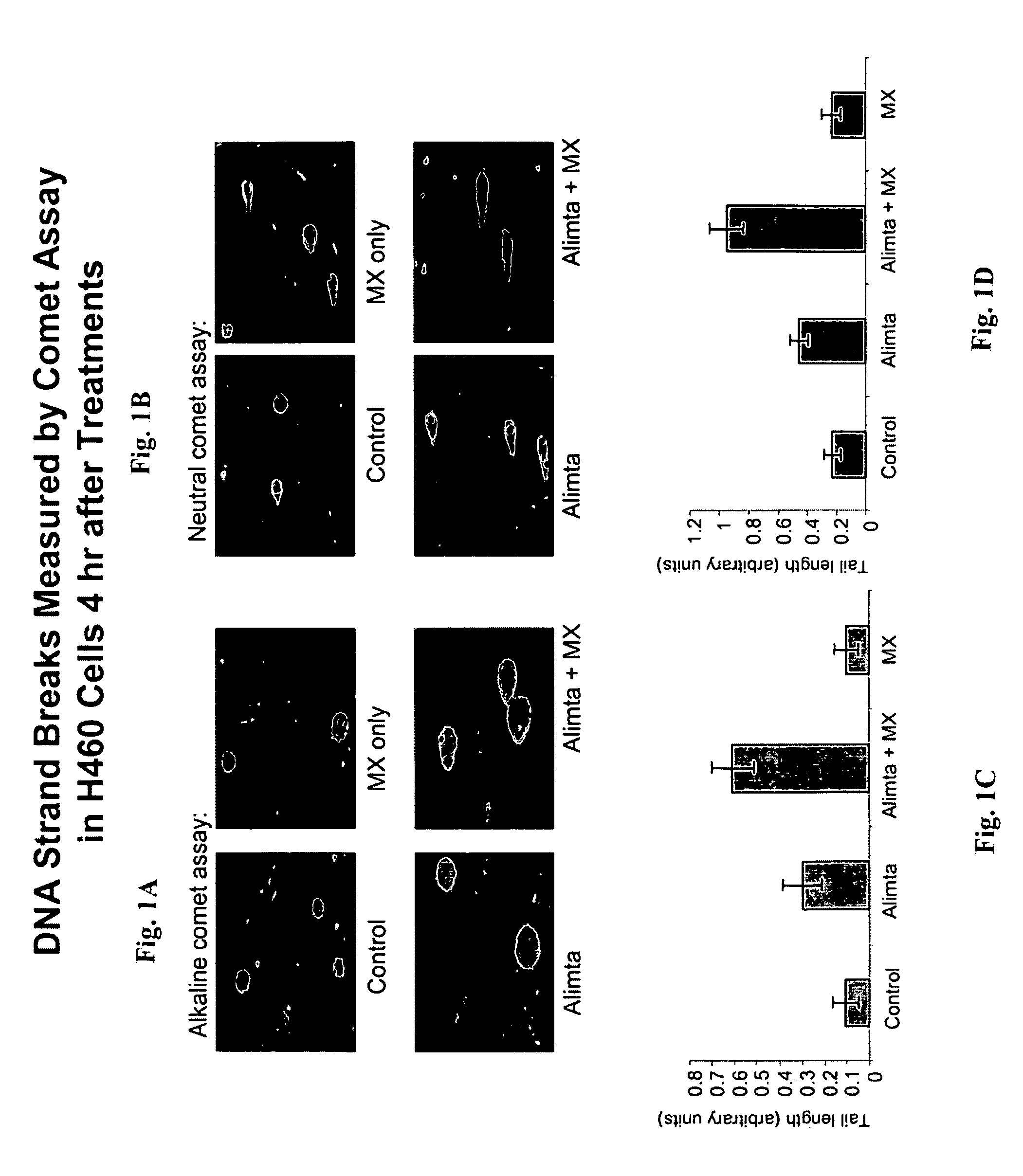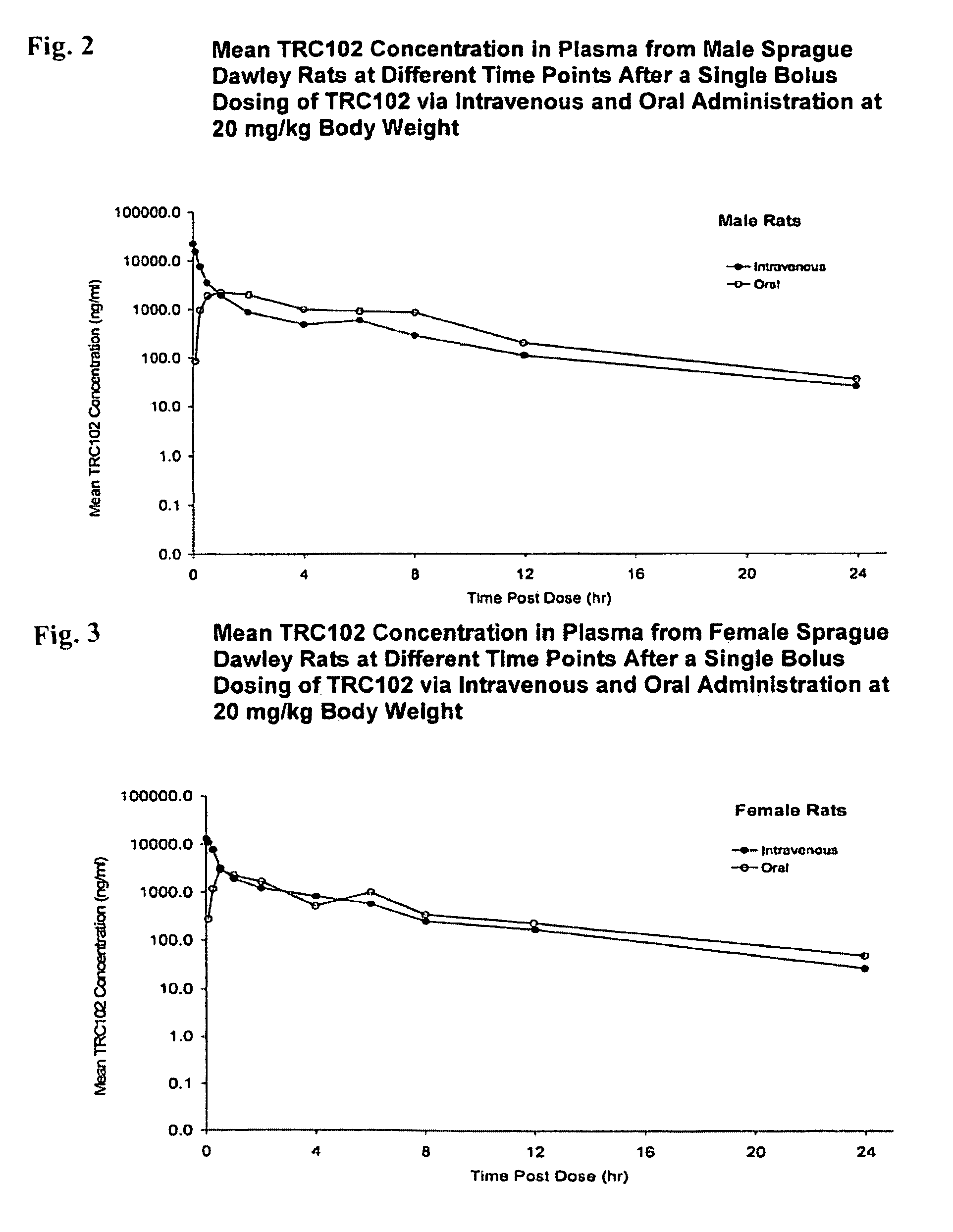Antifolate agent combinations in the treatment of cancer
a technology of antimetabolites and compounds, applied in the field of compounds, can solve the problems of high but transient drug exposure, complex drug infusion apparatus, and inhibitors of ber that reverse resistance to chemotherapy, and have not been developed to date. , to achieve the effect of enhancing or increasing the effect, and reducing the risk of cancer
- Summary
- Abstract
- Description
- Claims
- Application Information
AI Technical Summary
Benefits of technology
Problems solved by technology
Method used
Image
Examples
example 1
[0178]FIG. 8 shows all groups receiving Methoxyamine (MX)+pemetrexed exhibited greater tumor growth delay compared to groups receiving only pemetrexed in the human NCI-H460 NSCLC cell line model, A549 NSCLC cell line model, HCT116 colon cancer cell line model and MDA-MB-468 breast cancer cell line model. MX reversed resistance of the NCI-H460 NSCLC cell line and HCT116 colon cancer cell line to the effects of pemetrexed chemotherapy.
example 2
[0179]To determine the effect of pemetrexed+methoxyamine (MX) compared to pemetrexed alone on the number of AP sites generated, an aldehyde reactive probe (ARP) reagent was used to measure AP sites formed by pemetrexed and blocked by MX. ARP and MX have a similar reactivity with AP sites, and react specifically with an aldehyde group, an open-ring form of the AP sites. The assay is described in Liu et al. (Molecular Cancer Therapeutics 2:1061-1066, 2003), and was performed essentially as described by Nakamura et al. (Cancer Res. 58:222-225, 1998). H460 cells were treated with pemetrexed (0, 100, 200 or 400 μm) for 24 hours. DNA (15 μg) was then extracted from cells and incubated with 1 mM ARP at 37° C. for 10 min. DNA was precipitated and washed with ethanol, then resuspended in TE buffer (10 mM Tris-HCl, pH 7.2, 1 mM EDTA) and denatured at 100° C. for 5 min. The DNA was then quickly chilled on ice and mixed with an equal amount of ammonium acetate (2 M). Single-stranded DNA was the...
example 3
[0181]A DNA strand break assay was performed to determine the ability of pemetrexed and methoxyamine (MX) to increase tumor cell death mediated by apoptosis and DNA strand break. The Comet assay is described in Liu et al. (supra.), and is based on the ability of denatured, cleaved DNA fragments to migrate out of the cell under influence of an electric field. Undamaged DNA migrates slower and remains within the confines of the nuclei when a current is applied. DNA damage was assessed in a cell based on evaluation of the DNA “comet” tail shape and migration distance (Helma et al., Mutat. Res. 466:9-15, 2000). Cells were harvested and washed with PBS after exposure to 200 μM pemetrexed, 6 mM MX, or 200 μM pemetrexed+6 mM MX, each for 4 hours. A suspension of H460 cells (1×105 / ml cold PBS) was mixed with 1% low gelling temperature agarose at 42° C. at a ratio of 1:10 (v / v) and 75 μl was immediately pipetted onto CometSlide (Trevigen, Inc., Gaithersburg, Md.). When the low gelling temper...
PUM
| Property | Measurement | Unit |
|---|---|---|
| pH | aaaaa | aaaaa |
| pH | aaaaa | aaaaa |
| volume | aaaaa | aaaaa |
Abstract
Description
Claims
Application Information
 Login to View More
Login to View More - R&D
- Intellectual Property
- Life Sciences
- Materials
- Tech Scout
- Unparalleled Data Quality
- Higher Quality Content
- 60% Fewer Hallucinations
Browse by: Latest US Patents, China's latest patents, Technical Efficacy Thesaurus, Application Domain, Technology Topic, Popular Technical Reports.
© 2025 PatSnap. All rights reserved.Legal|Privacy policy|Modern Slavery Act Transparency Statement|Sitemap|About US| Contact US: help@patsnap.com



